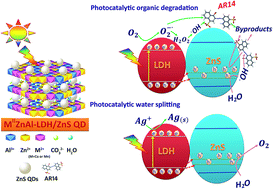ZnS quantum dot intercalated layered double hydroxide semiconductors for solar water splitting and organic pollutant degradation†
Abstract
Heterostructured nanocomposites consisting of MIIZnAl-layered double hydroxide/ZnS quantum dots (MII = Co or Mn) are constructed to utilize the unique properties of the wide band gap ZnS quantum dots (QDs) and layered double hydroxides (LDHs) for visible light driven photocatalytic applications. The nanocomposites were synthesized via the in situ growth of oppositely charged 2D LDHs in the presence of negatively charged ZnS QDs. The partial intercalating of ZnS QDs in the interlayer space of the LDHs is evidenced by powder X-ray diffraction results. In comparison with ZnS QDs and pristine LDHs, the prepared CoZnAl-LDH/ZnS and MnZnAl-LDH/ZnS heterostructures show surprisingly enhanced visible light harvesting ability with an expansion of the ligand to metal charge transfer absorption edge to visible wavelengths. The obtained results imply effective electronic coupling between ZnS QDs and LDHs. The charge carrier recombination is largely suppressed, as indicated by the photoluminescence and electrochemical impedance spectroscopy results. From the Tauc and Mott–Schottky plots, the band structures of the synthesized heterostructures were determined. The resulting heterostructures reveal promising activity for visible light photocatalytic oxygen evolution via water splitting and the degradation of Acid Red 14, as a model organic pollutant, and significantly enhanced photostability, much superior to pristine LDHs and ZnS QDs.



 Please wait while we load your content...
Please wait while we load your content...